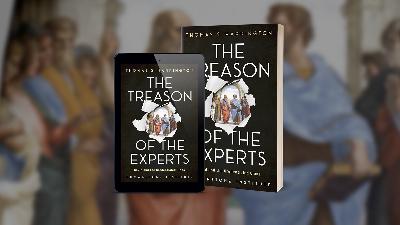The Perception of Reality
Update: 2025-09-29
Description
By Russ Gonnering at Brownstone dot org.
Ten years ago, the internet was completely captured by "The Dress."
A photo of a dress was displayed. Was it Blue and Black? Was it White and Gold? Everybody had an opinion, and it was definite.
This is distinct from other optical illusions, such as The Rubin Vase, which can be easily reversed by most people:
The Dress launched a flurry of scientific inquiries in an attempt to explain the science behind this. The Journal of Vision, a respected academic ophthalmology journal, launched an open-access special edition in an attempt to explain these curious findings on the basis of multiple objective measurements of luminosity, color saturation, assumptions on illumination with natural or artificial light, and prior exposure to long or short wavelengths.
Perhaps the most interesting explanation, and one that is more easily understood by a lay audience, is contained in an issue of Wired magazine:
So, when context varies, so will people's visual perception. "Most people will see the blue on the white background as blue," Conway says. "But on the black background some might see it as white." He even speculated, perhaps jokingly, that the white-gold prejudice favors the idea of seeing the dress under strong daylight. "I bet night owls are more likely to see it as blue-black," Conway says.
Importantly, it made no difference if it was known by the viewer of the photo that the real dress was blue and black…
Is there a larger lesson that can be learned from this? If illumination and context of a representation of reality of a physical object form perception of that reality, can the same be true of other, less tangible things, such as ideas? I believe so.
The last decade has seen a profound and deepening divide on multiple issues. Consider the recent heated exchanges during the meeting of the Advisory Committee on Immunization Practices (ACIP) of the CDC. Unless one took the time to watch the two days of the meeting, only a summary, most often as a news report, is available. One sees a representation of the actual meeting.
Just as when looking at a photo of The Dress, perception will be greatly influenced by the context and the illumination of the representation. However, this time it is not only the context and illumination of the viewer, but also that of the producer of the news.
Herein lies the problem. How can we ever arrive at a true representation of reality? During the Great Covid Disaster, I kept thinking that if only the actual unbiased data could be shared with those who insisted the virus evolved naturally, or those who believed early treatment was impossible, or those who insisted the mRNA agents were "safe and effective," the impasse could be broken. Alas, that never happened because the source of illumination had been altered from what it was in the past.
With the advent of Postmodernism, the literal definition of truth itself has changed. The truth has been replaced by my truth and your truth. Truth has become an opinion, no more important than whether you like your steak rare or medium.
In the past, we relied on ethical medical science to lead the way to find the truth, but is that even possible now? In current medical studies, it seems that the conclusions are now made first, then the study is designed to fit those conclusions. A recently published study on a trial of a new drug to treat hypertension had this statement appended to the end:
The sponsor designed and conducted the study, including collection, management, analysis, and interpretation of the data. The sponsor was involved in the preparation, review, and approval of the manuscript and decision to submit the manuscript for publication in collaboration with all authors. The final decision on content was exclusively retained by the authors.
I realize that drug companies are interested in proving their products indeed help people, but if the drug manufacturer "designs and conducts the study, including collection, manageme...
Ten years ago, the internet was completely captured by "The Dress."
A photo of a dress was displayed. Was it Blue and Black? Was it White and Gold? Everybody had an opinion, and it was definite.
This is distinct from other optical illusions, such as The Rubin Vase, which can be easily reversed by most people:
The Dress launched a flurry of scientific inquiries in an attempt to explain the science behind this. The Journal of Vision, a respected academic ophthalmology journal, launched an open-access special edition in an attempt to explain these curious findings on the basis of multiple objective measurements of luminosity, color saturation, assumptions on illumination with natural or artificial light, and prior exposure to long or short wavelengths.
Perhaps the most interesting explanation, and one that is more easily understood by a lay audience, is contained in an issue of Wired magazine:
So, when context varies, so will people's visual perception. "Most people will see the blue on the white background as blue," Conway says. "But on the black background some might see it as white." He even speculated, perhaps jokingly, that the white-gold prejudice favors the idea of seeing the dress under strong daylight. "I bet night owls are more likely to see it as blue-black," Conway says.
Importantly, it made no difference if it was known by the viewer of the photo that the real dress was blue and black…
Is there a larger lesson that can be learned from this? If illumination and context of a representation of reality of a physical object form perception of that reality, can the same be true of other, less tangible things, such as ideas? I believe so.
The last decade has seen a profound and deepening divide on multiple issues. Consider the recent heated exchanges during the meeting of the Advisory Committee on Immunization Practices (ACIP) of the CDC. Unless one took the time to watch the two days of the meeting, only a summary, most often as a news report, is available. One sees a representation of the actual meeting.
Just as when looking at a photo of The Dress, perception will be greatly influenced by the context and the illumination of the representation. However, this time it is not only the context and illumination of the viewer, but also that of the producer of the news.
Herein lies the problem. How can we ever arrive at a true representation of reality? During the Great Covid Disaster, I kept thinking that if only the actual unbiased data could be shared with those who insisted the virus evolved naturally, or those who believed early treatment was impossible, or those who insisted the mRNA agents were "safe and effective," the impasse could be broken. Alas, that never happened because the source of illumination had been altered from what it was in the past.
With the advent of Postmodernism, the literal definition of truth itself has changed. The truth has been replaced by my truth and your truth. Truth has become an opinion, no more important than whether you like your steak rare or medium.
In the past, we relied on ethical medical science to lead the way to find the truth, but is that even possible now? In current medical studies, it seems that the conclusions are now made first, then the study is designed to fit those conclusions. A recently published study on a trial of a new drug to treat hypertension had this statement appended to the end:
The sponsor designed and conducted the study, including collection, management, analysis, and interpretation of the data. The sponsor was involved in the preparation, review, and approval of the manuscript and decision to submit the manuscript for publication in collaboration with all authors. The final decision on content was exclusively retained by the authors.
I realize that drug companies are interested in proving their products indeed help people, but if the drug manufacturer "designs and conducts the study, including collection, manageme...
Comments
In Channel























